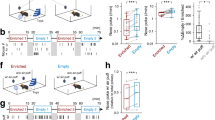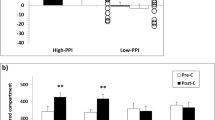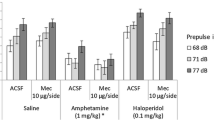Abstract
The acoustic startle response is enhanced during states of fear and attenuated during pleasant ones. Our question was whether pharmacological stimulation of the reward system disrupts the learning and retrieval of conditioned fear as measured by fear-potentiated startle. We therefore injected the dopamine agonist amphetamine into the nucleus accumbens (NAC) immediately before either acquisition or expression of conditioned fear and measured the effect of these injections on fear-potentiated startle and baseline startle response. This study clearly showed that amphetamine injections into the NAC had no effect on baseline startle amplitude and acquisition/expression of conditioned fear. In contrast, amphetamine injections into the nucleus accumbens clearly enhanced spontaneous motor activity. These results suggest that dopamine within the NAC is not involved in modulation of fear-potentiated startle and baseline startle.



Similar content being viewed by others
References
Anderson R, Diotte M, Miliaressis E (1995) The bidirectional interaction between ventral tegmental rewarding and hindbrain aversive stimulation effects in the rat. Brain Res 688:15–20
Brandao ML, Rees H, Witt S, Roberts MH (1991) Central antiaversive and antinociceptive effects of anterior pretectal nucleus stimulation: attenuation of autonomic and aversive effects of medial hypothalamic stimulation. Brain Res 542:266–272
Carboni E, Imperato A, Perezzani L, Di Chiara G (1989) Amphetamine, cocaine, phencyclidine and nomifensine increase extracellular dopamine concentrations preferentially in the nucleus accumbens of freely moving rats. Neuroscience 28:653–661
Cardinal RN, Parkinson JA, Hall J, Everitt BJ (2002) Emotion and motivation: the role of the amygdala, ventral striatum, and prefrontal cortex. Neurosci Biobehav Rev 26:321–352
Carr GD, White NM (1983) Conditioned place preference from intra-accumbens but not intra-caudate amphetamine injections. Life Sci 33:2551–2557
Carr GD, White NM (1986) Anatomical disassociation of amphetamine’s rewarding and aversive effects: an intracranial microinjection study. Psychopharmacology (Berl) 89:340–346
Davis M, Falls WA, Kim M (1993) Fear-potentiated startle: a neural and pharmacological analysis. Behav Brain Res 58:175–198
Dickinson A, Pearce JM (1977) Inhibitory interactions between appetitive and aversive stimuli. Psychol Bull 84:690–711
Fendt M, Fanselow MS (1999) The neuroanatomical and neurochemical basis of conditioned fear. Neurosci Biobehav Rev 23:743–760
Fendt M, Schmid S (2002) Metabotropic glutamate receptors are involved in amygdaloid plasticity. Eur J Neurosci 15:1535–1541
Fletcher PJ, Korth KM, Sabijan MS, DeSousa NJ (1998) Injections of D-amphetamine into the ventral pallidum increase locomotor activity and responding for conditioned reward: a comparison with injections into the nucleus accumbens. Brain Res 805:29–40
Grauer E, Thomas E (1982) Conditioned suppression of medial forebrain bundle and septal intracranial self-stimulation in the rat: evidence for a fear-relief mechanism of the septum. J Comp Physiol Psychol 96:61–70
Hanlon EC, Baldo BA, Sadeghian K, Kelley AE (2003) Increases in food intake or food-seeking behavior induced by GABAergic, opioid, or dopaminergic stimulation of the nucleus accumbens: is it hunger? Psychopharmacology (Berl) 172:241–247
Haralambous T, Westbrook RF (1999) An infusion of bupivacaine into the nucleus accumbens disrupts the acquisition but not the expression of contextual fear conditioning. Behav Neurosci 113:925–940
Hernandez L, Hoebel BG (1988) Food reward and cocaine increase extracellular dopamine in the nucleus accumbens as measured by microdialysis. Life Sci 42:1705–1712
Hernandez L, Lee F, Hoebel BG (1987) Simultaneous microdialysis and amphetamine infusion in the nucleus accumbens and striatum of freely moving rats: increase in extracellular dopamine and serotonin. Brain Res Bull 19:623–628
Hernandez-Lopez S, Bargas J, Surmeier DJ, Reyes A, Galarraga E (1997) D1 receptor activation enhances evoked discharge in neostriatal medium spiny neurons by modulating an L-type Ca2+ conductance. J Neurosci 17:3334–3342
Hernandez-Lopez S, Tkatch T, Perez-Garci E, Galarraga E, Bargas J, Hamm H, Surmeier DJ (2000) D2 dopamine receptors in striatal medium spiny neurons reduce L-type Ca2+ currents and excitability via a novel PLC[beta]1-IP3-calcineurin-signaling cascade. J Neurosci 20:8987–8995
Hoebel BG, Monaco AP, Hernandez L, Aulisi EF, Stanley BG, Lenard L (1983) Self-injection of amphetamine directly into the brain. Psychopharmacology (Berl) 81:158–163
Ikemoto S, Glazier BS, Murphy JM, McBride WJ (1998) Rats self-administer carbachol directly into the nucleus accumbens. Physiol Behav 63:811–814
Ison JR, Krauter EE (1975) Acoustic startle reflexes in the rat during consummatory behavior. J Comp Physiol Psychol 89:39–49
Jongen-Relo AL, Kaufmann S, Feldon J (2003) A differential involvement of the shell and core subterritories of the nucleus accumbens of rats in memory processes. Behav Neurosci 117:150–168
Koch M (1999) The neurobiology of startle. Prog Neurobiol 59:107–128
Koch M, Schmid A, Schnitzler HU (1996) Pleasure-attenuation of startle is disrupted by lesions of the nucleus accumbens. Neuroreport 7:1442–1446
Lang PJ (1995) The emotion probe. Studies of motivation and attention. Am Psychol 50:372–385
Lang PJ, Bradley MM, Cuthbert BN (1998) Emotion and motivation: measuring affective perception. J Clin Neurophysiol 15:397–408
Lorenzini CA, Baldi E, Bucherelli C, Tassoni G (1995) Time-dependent deficits of rat’s memory consolidation induced by tetrodotoxin injections into the caudate-putamen, nucleus accumbens, and globus pallidus. Neurobiol Learn Mem 63:87–93
Nicola SM, Surmeier J, Malenka RC (2000) Dopaminergic modulation of neuronal excitability in the striatum and nucleus accumbens. Annu Rev Neurosci 23:185–215
Olds J (1958) Self-stimulation of the brain. Science 127:315–324
Parkinson JA, Robbins TW, Everitt BJ (1999) Selective excitotoxic lesions of the nucleus accumbens core and shell differentially affect aversive Pavlovian conditioning to discrete and contextual cues. Psychobiology 27:256–266
Paxinos G, Watson C (1997) The rat brain in stereotaxic coordinates. Plenum Press, San Diego
Pellegrino LJ, Pellegrino AS, Cushman AJ (1979) A stereotaxic atlas of the rat brain. Plenum Press, New York
Pezze MA, Heidbreder CA, Feldon J, Murphy CA (2001) Selective responding of nucleus accumbens core and shell dopamine to aversively conditioned contextual and discrete stimuli. Neuroscience 108:91–102
Pfaus JG, Damsma G, Nomikos GG, Wenkstern DG, Blaha CD, Phillips AG, Fibiger HC (1990) Sexual behavior enhances central dopamine transmission in the male rat. Brain Res 530:345–348
Phillips GD, Robbins TW, Everitt BJ (1994) Bilateral intra-accumbens self-administration of d-amphetamine: antagonism with intra-accumbens SCH-23390 and sulpiride. Psychopharmacology (Berl) 114:477–485
Riedel G, Harrington NR, Hall G, Macphail EM (1997) Nucleus accumbens lesions impair context, but not cue, conditioning in rats. Neuroreport 8:2477–2481
Salamone JD (1994) The involvement of nucleus accumbens dopamine in appetitive and aversive motivation. Behav Brain Res 61:117–133
Schildein S, Agmo A, Huston JP, Schwarting RK (1998) Intraaccumbens injections of substance P, morphine and amphetamine: effects on conditioned place preference and behavioral activity. Brain Res 790:185–194
Schmid A, Koch M, Schnitzler HU (1995) Conditioned pleasure attenuates the startle response in rats. Neurobiol Learn Mem 64:1–3
Schulz B, Fendt M, Schnitzler HU (2002) Clonidine injections into the lateral nucleus of the amygdala block acquisition and expression of fear-potentiated startle. Eur J Neurosci 15:151–157
Schulz B, Fendt M, Richardson R, Schnitzler HU (2004) Temporary inactivation of the perirhinal cortex by muscimol injections block acquisition and expression of fear-potentiated startle. Eur J Neurosci 19:713–720
Schwienbacher I, Fendt M, Richardson R, Schnitzler H-U (2004) Temporary inactivation of the nucleus accumbens disrupts acquisition and expression of fear-potentiated startle in rats. Brain Res 1027:87–93
Sharp T, Zetterstrom T, Ljungberg T, Ungerstedt U (1987) A direct comparison of amphetamine-induced behaviours and regional brain dopamine release in the rat using intracerebral dialysis. Brain Res 401:322–330
Steidl S, Li L, Yeomans JS (2001) Conditioned brain-stimulation reward attenuates the acoustic startle reflex in rats. Behav Neurosci 115:710–717
Wilkinson LS, Humby T, Killcross AS, Torres EM, Everitt BJ, Robbins TW (1998) Dissociations in dopamine release in medial prefrontal cortex and ventral striatum during the acquisition and extinction of classical aversive conditioning in the rat. Eur J Neurosci 10:1019–1026
Wise RA, Rompre PP (1989) Brain dopamine and reward. Annu Rev Psychol 40:191–225
Yoshida M, Yokoo H, Mizoguchi K, Kawahara H, Tsuda A, Nishikawa T, Tanaka M (1992) Eating and drinking cause increased dopamine release in the nucleus accumbens and ventral tegmental area in the rat: measurement by in vivo microdialysis. Neurosci Lett 139:73–76
You ZB, Tzschentke TM, Brodin E, Wise RA (1998) Electrical stimulation of the prefrontal cortex increases cholecystokinin, glutamate, and dopamine release in the nucleus accumbens: an in vivo microdialysis study in freely moving rats. J Neurosci 18:6492–6500
Young AM, Joseph MH, Gray JA (1993) Latent inhibition of conditioned dopamine release in rat nucleus accumbens. Neuroscience 54:5–9
Young AM, Ahier RG, Upton RL, Joseph MH, Gray JA (1998) Increased extracellular dopamine in the nucleus accumbens of the rat during associative learning of neutral stimuli. Neuroscience 83:1175–1183
Acknowledgements
This work was supported by the Deutsche Forschungsgemeinschaft (SFB 550 C8 and Graduiertenkolleg Neurobiologie Tübingen). We thank Mrs. Helga Zillus for her excellent technical assistance.
Author information
Authors and Affiliations
Corresponding author
Rights and permissions
About this article
Cite this article
Schwienbacher, I., Fendt, M. & Schnitzler, HU. Amphetamine injections into the nucleus accumbens affect neither acquisition/expression of conditioned fear nor baseline startle response. Exp Brain Res 160, 538–544 (2005). https://doi.org/10.1007/s00221-004-2160-2
Received:
Accepted:
Published:
Issue Date:
DOI: https://doi.org/10.1007/s00221-004-2160-2




